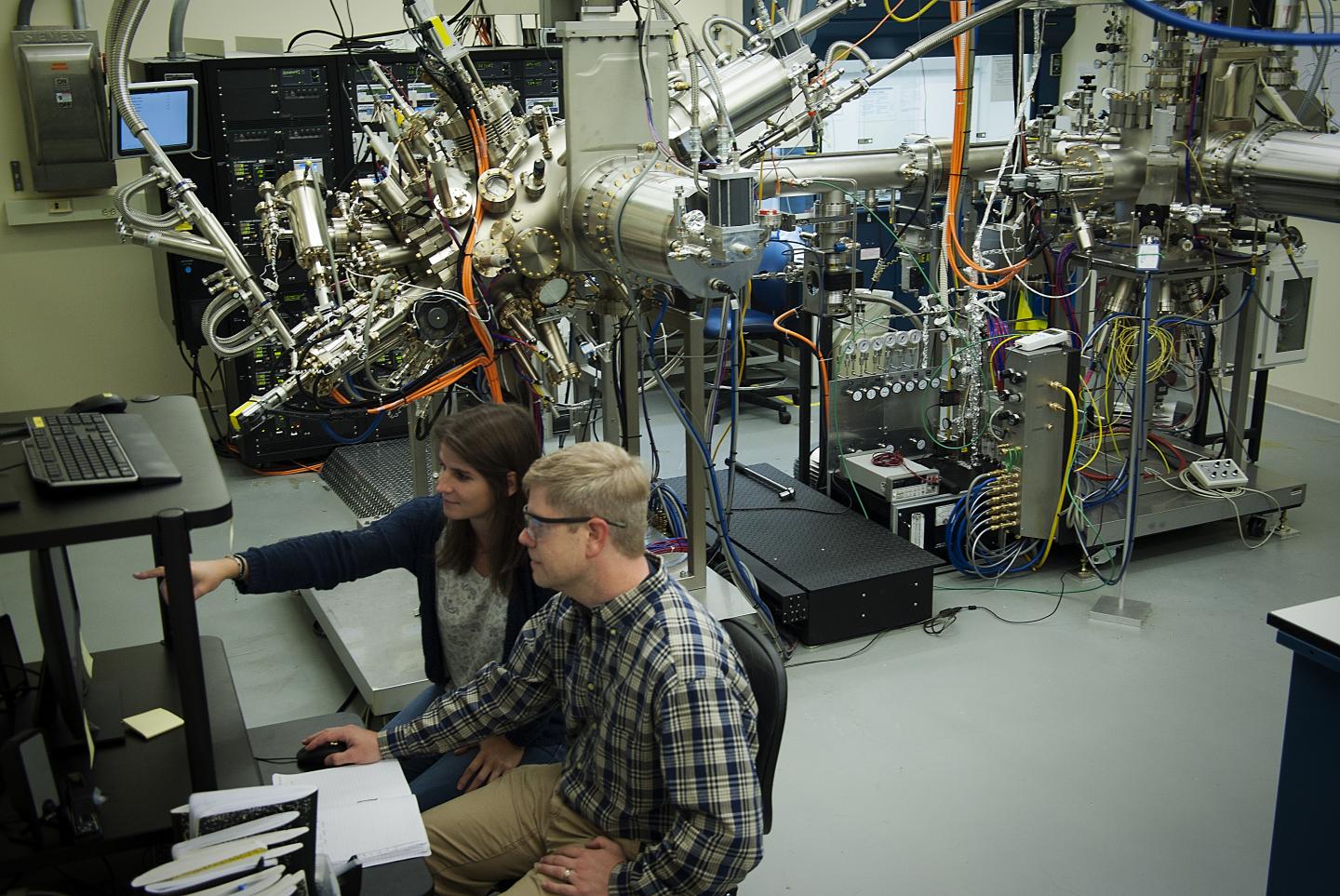

Researchers at various Microsoft Quantum lab sites, including the lab of Michael Manfra at Purdue University, collaborated to create a device that could bring more scalable quantum bits. Pictured here are Purdue researchers Candice Thomas (left) and Geoff Gardner.
Credit: Microsoft Station Q Purdue photo
Researchers have been trying for many years to build a quantum computer that industry could scale up, but the building blocks of quantum computing, qubits, still aren't robust enough to handle the noisy environment of what would be a quantum computer.
A theory developed only two years ago proposed a way to make qubits more resilient through combining a semiconductor, indium arsenide, with a superconductor, aluminum, into a planar device. Now, this theory has received experimental support in a device that could also aid the scaling of qubits.
This semiconductor-superconductor combination creates a state of “topological superconductivity,” which would protect against even slight changes in a qubit's environment that interfere with its quantum nature, a renowned problem called “decoherence.”
The device is potentially scalable because of its flat “planar” surface – a platform that industry already uses in the form of silicon wafers for building classical microprocessors.
The work, published in Nature, was led by the Microsoft Quantum lab at the University of Copenhagen's Niels Bohr Institute, which fabricated and measured the device. The Microsoft Quantum lab at Purdue University grew the semiconductor-superconductor heterostructure using a technique called molecular beam epitaxy, and performed initial characterization measurements.
Theorists from Station Q, a Microsoft Research lab in Santa Barbara, California, along with the University of Chicago and the Weizmann Institute of Science in Israel, also participated in the study.
“Because planar semiconductor device technology has been so successful in classical hardware, several approaches for scaling up a quantum computer having been building on it,” said Michael Manfra, Purdue University's Bill and Dee O'Brien Chair Professor of Physics and Astronomy, and professor of electrical and computer engineering and materials engineering, who leads Purdue's Microsoft Station Q site.
These experiments provide evidence that aluminum and indium arsenide, when brought together to form a device called a Josephson junction, can support Majorana zero modes, which scientists have predicted possess topological protection against decoherence.
It's also been known that aluminum and indium arsenide work well together because a supercurrent flows well between them.
This is because unlike most semiconductors, indium arsenide doesn't have a barrier that prevents the electrons of one material from entering another material. This way, the superconductivity of aluminum can make the top layers of indium arsenide, a semiconductor, superconducting, as well.
“The device isn't operating as a qubit yet, but this paper shows that it has the right ingredients to be a scalable technology,” said Manfra, whose lab specializes in building platforms for, and understanding the physics of, upcoming quantum technologies.
Combining the best properties of superconductors and semiconductors into planar structures, which industry could readily adapt, could lead to making quantum technology scalable. Trillions of switches, called transistors, on a single wafer currently allow classical computers to process information.
“This work is an encouraging first step towards building scalable quantum technologies,” Manfra said.
###
Work at Purdue was financially supported by Microsoft Corp.
ABSTRACT
Evidence of Topological Superconductivity in Planar Josephson Junctions
Antonio Fornieri,1 Alexander M. Whiticar,1 F. Setiawan,2 Elías Portolés Marín,1 Asbjørn C. C. Drachmann,1Anna Keselman,3 Sergei Gronin,4,5 Candice Thomas,4, 5 Tian Wang,4, 5 Ray Kallaher,5, 6 Geoffrey C. Gardner,5, 6Erez Berg,2, 7 Michael J. Manfra,4, 5, 8, 9 Ady Stern,7 Charles M. Marcus,1 and Fabrizio Nichele1
1Center for Quantum Devices and Station Q Copenhagen, Niels Bohr Institute, University of Copenhagen, Universitetsparken 5, 2100 Copenhagen, Denmark
2James Franck Institute, The University of Chicago, Chicago, IL 60637, USA
3Station Q, Microsoft Research, Santa Barbara, California 93106-6105, USA
4Department of Physics and Astronomy and Station Q Purdue, Purdue University, West Lafayette, Indiana 47907 USA
5Birck Nanotechnology Center, Purdue University, West Lafayette, Indiana 47907 USA
6Microsoft Quantum at Station Q Purdue, Purdue University, West Lafayette, Indiana 47907, USA
7Department of Condensed Matter Physics, Weizmann Institute of Science, Rehovot 7610001, Israel
8School of Materials Engineering, Purdue University, West Lafayette, Indiana 47907 USA
9School of Electrical and Computer Engineering, Purdue University, West Lafayette, Indiana 47907 USA
doi: 10.1038/s41586-019-1068-8
Majorana zero modes–quasiparticle states localized at the boundaries of topological superconductors–are expected to be ideal building blocks for fault-tolerant quantum computing1,2. Several observations of zero-bias conductance peaks measured by tunnelling spectroscopy above a critical magnetic field have been reported as experimental indications of Majorana zero modes in superconductor-semiconductor nanowires3,4,5,6,7,8. On the other hand, two-dimensional systems offer the alternative approach of confining Majorana channels within planar Josephson junctions, in which the phase difference φ between the superconducting leads represents an additional tuning knob that is predicted to drive the system into the topological phase at lower magnetic fields than for a system without phase bias9,10. Here we report the observation of phase-dependent zero-bias conductance peaks measured by tunnelling spectroscopy at the end of Josephson junctions realized on a heterostructure consisting of aluminium on indium arsenide. Biasing the junction to φ ≈ π reduces the critical field at which the zero-bias peak appears, with respect to φ = 0. The phase and magnetic-field dependence of the zero-energy states is consistent with a model of Majorana zero modes in finite-size Josephson junctions. As well as providing experimental evidence of phase-tuned topological superconductivity, our devices are compatible with superconducting quantum electrodynamics architectures11 and are scalable to the complex geometries needed for topological quantum computing9,12,13.












